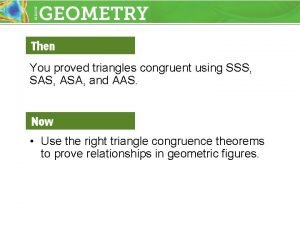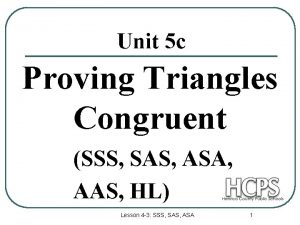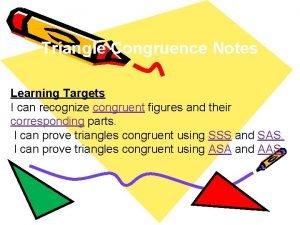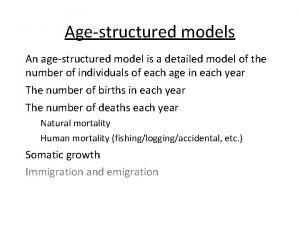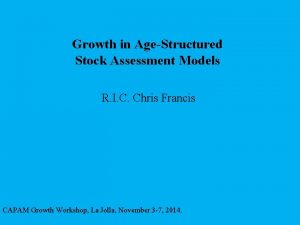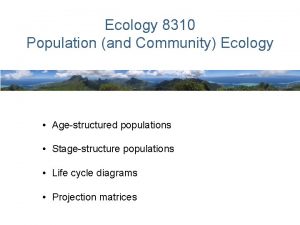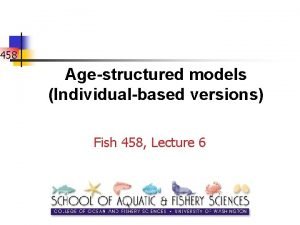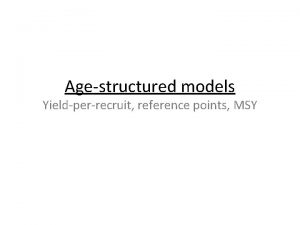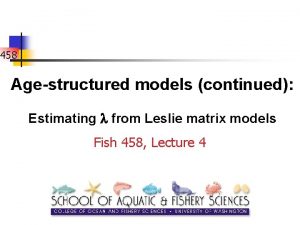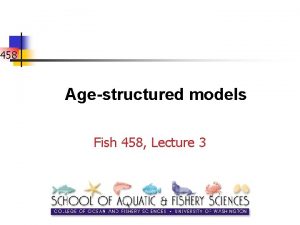Agestructured population assessment models Intro ASA agestructured assessment










- Slides: 10

Age-structured population assessment models

Intro • ASA (age-structured assessment) models permit reconstruction of the population dynamics • Provide estimates of mortality rates and population abundance • ASA is the primary method used for providing management advice

Advantages • Can be applied without knowledge of: • Fishing effort • Catchability • Gear selectivity • Do not rely on FD CPUE as an IOA (a common problem with earlier assessment models) • Hyper depletion patterns bias • Availability of “aged catch” data, starting in the 1960’s has lead to widespread use. • Rise of “microcomputing” Moore’s Law

Historical roots • Derzhavin (1922) first to apply data describing age structure of a population to catch statistics in order to calculate the contribution of each cohort to each years’ total catch • Derived from Baranov (1918) • Catch (in numbers) is a function of initial population abundance, fishing, and natural mortality M.

Question: • Consider a population of 1, 200 age-0 fish. • 30% lost to natural mortality, 40% lost to fishing mortality. Fishing occurs on ages 2 to 6. • Create a table with columns: • Year, Abundance (F = 0), Abundance (F = realized F), Catch

Historical roots • In an age-structured population, the population size of a cohort as it enters the exploitable phase can be approximated by summing the catches removed from the cohort during the years it contributes to the fishery. • Summing catch provides an estimate of the population must have been alive in order to generated the observed catches. • Use mean age composition of the catch data from many years.

Historical roots • Derzhavin (1922) analysis provides the minimum estimate of the total population • Ignores M • Use of mean estimate does not allow understanding of annual trends • Provides a minimum estimate of total population size

Historical roots • Beverton (1954) and Beverton and Holt (1957) proposed agestructured models that emphasized the estimation of M • Formulations allow population reconstruction. • Terminal F problem – reconstructions are very sensitive to the ‘terminal’ F value. • Unfortunately, this is the exact information needed by fisheries managers…. • Pope’s (1972) resolution – change exponential decay with a step function – computationally much simpler.

Seperability assumption •

ASA data sources • Catch-at-age • Observed from catch-at-length • Use length-at-age conversion • Total catch • Determine age composition of catch • Effort data • Stratified by gear type • Integrated analysis… • Incorporate many, many data sources • “tuned”
 Chapter 4 population ecology worksheet answer key
Chapter 4 population ecology worksheet answer key Section 1 population dynamics answer key
Section 1 population dynamics answer key Population ecology section 1 population dynamics
Population ecology section 1 population dynamics Chapter 4 section 1 population dynamics answer key
Chapter 4 section 1 population dynamics answer key Modals and semi-modals
Modals and semi-modals Population health risk assessment and management
Population health risk assessment and management Fish population dynamics and stock assessment
Fish population dynamics and stock assessment Right triangle congruence theorems
Right triangle congruence theorems Proving two triangles are congruent
Proving two triangles are congruent Asa and aas difference
Asa and aas difference Asa postulate example
Asa postulate example







